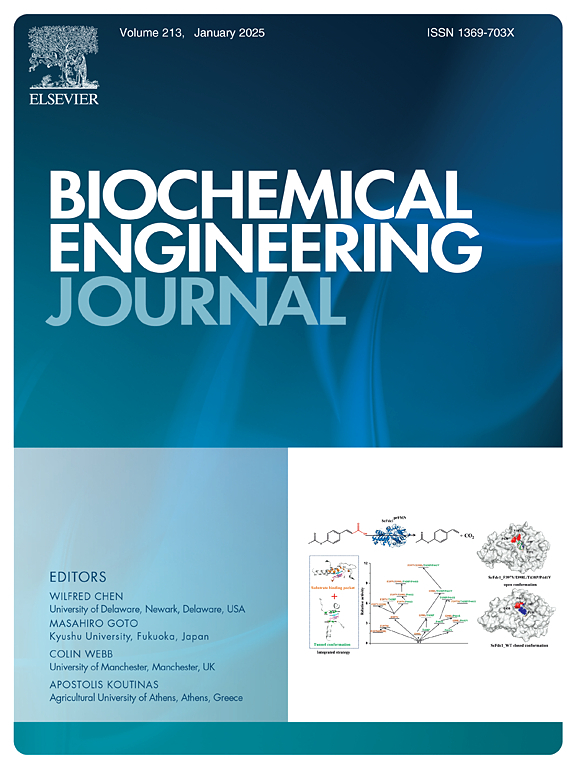Development of inducible packaging cell line for rAAV production via CRISPR-Cas9 mediated site-specific integration
IF 3.7
3区 生物学
Q2 BIOTECHNOLOGY & APPLIED MICROBIOLOGY
引用次数: 0
Abstract
AAV-mediated gene therapy is a quickly growing segment of the pharmaceutical market; however, the current transient transfection process to produce rAAV has several challenges. The stable cells are ideal for large-scale continuous production, overcoming the drawbacks in the current transient transfection and streamlining rAAV production. In this study, we proposed to use synthetic inducible promoters to control the viral component expression and develop the baseline of HEK293T stable cells via site-specific integration mediated with CRISPR-Cas9, targeting safe harbor sites of human genome (ROSA26, AAVS1, and CCR5 locus). With a total of three round integrations, stable cell pools were developed and evaluated at each round of integration. Single clones were further characterized for each integration round. Regarding the stable pools, the 5’ and 3’ junction PCR results confirmed the site-specific integration to each locus. The genome copy result showed that AAV components, including Rep78/68, E2A, E4orf6, Cap, and Rep52/40, were successfully integrated into the host cell genome. Genome and capsid titer after induction confirmed rAAV production for stable cell pools in each round. The packaging cell line (after 2nd round integration) was able to produce rAAV. However, it was observed that the genome titer was ten-fold lower than that of rAAV products done with triple plasmids transfection. The out-to-out PCR and qPCR assay results further confirm the site-specific integration. This research demonstrates the feasibility of developing the inducible stable cell line with the refactored viral vectors via a site-specific integration.
通过 CRISPR-Cas9 介导的位点特异性整合,开发用于生产 rAAV 的可诱导包装细胞系
AAV 介导的基因疗法是医药市场中一个快速增长的细分市场;然而,目前生产 rAAV 的瞬时转染工艺面临着一些挑战。稳定细胞是大规模连续生产的理想选择,它克服了目前瞬时转染的缺点,简化了 rAAV 的生产过程。在本研究中,我们提出使用合成诱导启动子来控制病毒成分的表达,并通过 CRISPR-Cas9 介导的位点特异性整合,以人类基因组的安全港位点(ROSA26、AAVS1 和 CCR5 位点)为目标,开发 HEK293T 稳定细胞基线。总共进行了三轮整合,在每一轮整合中都开发并评估了稳定细胞池。对每轮整合的单克隆进行了进一步鉴定。关于稳定细胞池,5'和 3'连接PCR结果证实了每个基因座的特异性整合。基因组拷贝结果显示,包括 Rep78/68、E2A、E4orf6、Cap 和 Rep52/40 在内的 AAV 成分已成功整合到宿主细胞基因组中。诱导后的基因组和囊壳滴度证实,每一轮都有稳定的细胞池产生了 rAAV。包装细胞系(第二轮整合后)能够产生 rAAV。但观察到基因组滴度比三重质粒转染的 rAAV 产物低十倍。从外到内的 PCR 和 qPCR 检测结果进一步证实了位点特异性整合。这项研究证明了通过位点特异性整合利用重构病毒载体开发可诱导的稳定细胞系的可行性。
本文章由计算机程序翻译,如有差异,请以英文原文为准。
求助全文
约1分钟内获得全文
求助全文
来源期刊

Biochemical Engineering Journal
工程技术-工程:化工
CiteScore
7.10
自引率
5.10%
发文量
380
审稿时长
34 days
期刊介绍:
The Biochemical Engineering Journal aims to promote progress in the crucial chemical engineering aspects of the development of biological processes associated with everything from raw materials preparation to product recovery relevant to industries as diverse as medical/healthcare, industrial biotechnology, and environmental biotechnology.
The Journal welcomes full length original research papers, short communications, and review papers* in the following research fields:
Biocatalysis (enzyme or microbial) and biotransformations, including immobilized biocatalyst preparation and kinetics
Biosensors and Biodevices including biofabrication and novel fuel cell development
Bioseparations including scale-up and protein refolding/renaturation
Environmental Bioengineering including bioconversion, bioremediation, and microbial fuel cells
Bioreactor Systems including characterization, optimization and scale-up
Bioresources and Biorefinery Engineering including biomass conversion, biofuels, bioenergy, and optimization
Industrial Biotechnology including specialty chemicals, platform chemicals and neutraceuticals
Biomaterials and Tissue Engineering including bioartificial organs, cell encapsulation, and controlled release
Cell Culture Engineering (plant, animal or insect cells) including viral vectors, monoclonal antibodies, recombinant proteins, vaccines, and secondary metabolites
Cell Therapies and Stem Cells including pluripotent, mesenchymal and hematopoietic stem cells; immunotherapies; tissue-specific differentiation; and cryopreservation
Metabolic Engineering, Systems and Synthetic Biology including OMICS, bioinformatics, in silico biology, and metabolic flux analysis
Protein Engineering including enzyme engineering and directed evolution.
 求助内容:
求助内容: 应助结果提醒方式:
应助结果提醒方式:


